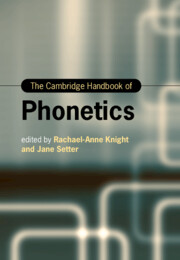Book contents
- The Cambridge Handbook of Phonetics
- Cambridge Handbooks in Language and Linguistics
- The Cambridge Handbook of Phonetics
- Copyright page
- Contents
- Figures
- Tables
- Contributors
- Introduction
- Section I Segmental Production
- 1 Physiological Foundations
- 2 Vowels
- 3 Consonants
- 4 Coarticulation
- 5 Processes in Connected Speech
- Section II Prosodic Production
- Section III Measuring Speech
- Section IV Audition and Perception
- Section V Applications of Phonetics
- Index
- References
1 - Physiological Foundations
from Section I - Segmental Production
Published online by Cambridge University Press: 11 November 2021
- The Cambridge Handbook of Phonetics
- Cambridge Handbooks in Language and Linguistics
- The Cambridge Handbook of Phonetics
- Copyright page
- Contents
- Figures
- Tables
- Contributors
- Introduction
- Section I Segmental Production
- 1 Physiological Foundations
- 2 Vowels
- 3 Consonants
- 4 Coarticulation
- 5 Processes in Connected Speech
- Section II Prosodic Production
- Section III Measuring Speech
- Section IV Audition and Perception
- Section V Applications of Phonetics
- Index
- References
Summary
Speech physiology consists of the articulatory structures, including the respiratory system, the larynx and various vocal tract articulators, plus the sensory organs, which provide auditory, somatosensory and visual inputs that map the feature space in which speech is produced and perceived. In this chapter the focus is on the neurophysiology of the articulatory structures. The acoustic characteristics of speech sounds are determined by changes in the length and tension of muscles, coordinated, at the lowest level, by interlinked clusters of motor neurons and interneurons in the brainstem which are themselves directed by excitation from cortical and midbrain structures. This chapter provides a brief foundation to these systems and structures, taking a functional perspective. The progressive nature of research into the anatomy and physiology of speech continues to generate new discoveries, and advances in modelling and mapping of biomechanical and neural control promise new avenues for phonetic research.
- Type
- Chapter
- Information
- The Cambridge Handbook of Phonetics , pp. 11 - 39Publisher: Cambridge University PressPrint publication year: 2021

